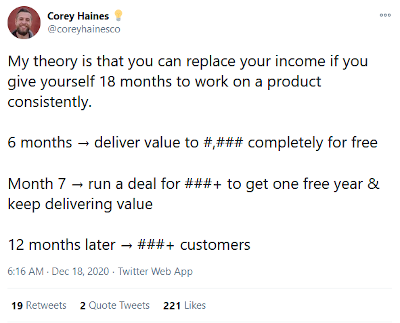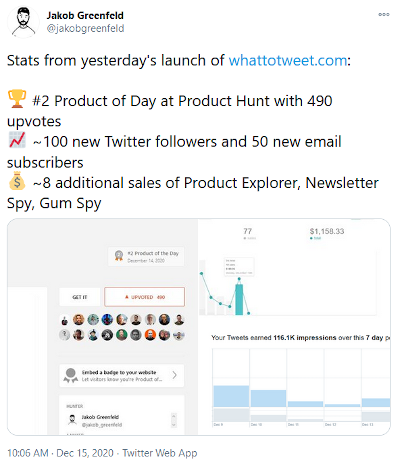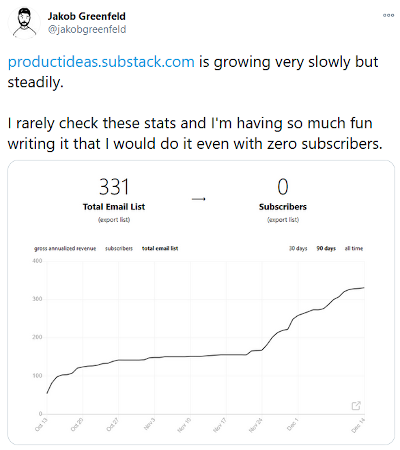🧠 Don't offer free stuff if you have nothing to sell
Two days ago Corey Haines shared the following framework.
In my humble opinion this tweet lays out perfectly what most indie makers do wrong.
- It’s extremely tough to stay motivated if you’re not earning any money from a project. The trough of sorrow is inevitable. But if people are paying for what you’re creating, you simply can’t stop. Paying customers are a perfect accountability system and will help you to get through tough times.
- Creating free stuff before you have something to sell is a form of procrastination. You’re just delaying validating if people are willing to pay for what you offer. The time you spend on your free projects could be used to validate multiple business ideas.
- Charging money allows you to create much higher quality products. Theoretically, you could of course do everything you would do for a paid product and make it freely available. But this is just not how the human mind works. Spending money on a free project feels like flushing money down the drain whereas I’m always happy to invest money into a paid product.
- It’s not even correct that it’s easier to get attention with a free product. A paywall makes people curious and will help you stick out. There are thousands of free newsletters but only a few that charge $30+ per month. And whenever I find a new one, I get curious what’s offered that justifies this price point.
- Also, if you’re earning some money it’s much easier to justify ad expenses which, of course, helps to make more people aware of your creation. Spending $100 for a newsletter shoutout can be no-brainer if you’ve something to sell.
- A more subtle way in which a paid product makes marketing easier, is that you’re able to give influencers a 100% discount code aka free access. In other words, you’re actually able to offer something whereas with a free product, you’re just someone who begs for attention. This brings us directly to the next point.
- Charging money completely changes the perception people have of you and what you’re doing. You’re not just a dude who posts random stuff on the internet but an author. You’re not just some kid who codes a bit after school but an entrepreneur. It’s not just a long blog post or random PDF but a book. It’s not just a YoutTube video, it’s a course. It’s not just a fun web app but software-as-a-service.
- Not just other people’s perception changes but also your self-image. As soon as people pay for your creations, you’re no longer an amateur. You’ll be more confident and give yourself permission to think about more ambitious projects.
- As paradoxical as it sounds, customers who pay good money are usually less demanding and nicer than free users or users who pay very little. Moreover, having just a small number of users that are actually paying money will allow you to give every single one of them the help that they need.
- Paying customers are far more motivated to engage with your creation. A PDF you found on some website is quickly forgotten but chances are high that you’ll actually read the book you bought for $49.99.
- Either you’re offering something valuable or you don’t. And if it’s valuable, people will pay for it.
To illustrate these arguments, let’s consider an example. Last week, I discussed the topic with Aswin, and he brought up a podcast episode with Seth Godin. Seth was asked, “how would you launch a new business with $1,000 and 90 days to spare?”
Seth proposes to create an amazing 50-page guide of the best Airbnbs in Paris and make it available for free on Medium. Then he would reach out to 10 people who fit the description of his ideal audience and hopefully will share the guide with their friends.
Moreover, he would include his email address at the bottom of the guide, expecting readers to contact him with questions. He would then “give great free advice, engaging with 100 to 1000 people a day back and forth, back and forth, until he’d the indispensable middle man”.
Finally, “Airbnb owners would pay him to write a review about their place, while American families will reach out to find the best Airbnb apartment in the city center of Paris for less than $250 a night.”
The gist of Seth’s approach is “to be trusted you must first give value for free.”
Is that really true?
Do you trust the author of a free guide on Medium more than someone who has published a proper book on the topic?
If you spend so much time to create an amazing 50-page guide, why not charge money for it?
After all, the point of the whole exercise is to earn money. You could certainly still include your email address to leverage the guide into consulting gigs. But while Seth recommends starting by giving free advice, why not charge money for your consultations from day one?
In Seth’s plan, the endgame is that you’re a paid consultant people hire when they want a nice Airbnb in Paris. But will people actually pay for this kind of service? If you can’t even sell a few book copies, chances are high that they won’t. If you follow Seth’s plan you might only learn this lessons after months of free work. In contrast, by starting with a paid product, you could immediately get some validation for your idea.
And if the guide is really great, people will recommend it to their friends anyway. Possibly, they would even feel more confident to recommend it, if it’s a proper book.
Another problem I’m seeing is, how motivated you really would be to keep your free guide up-to-date? But if you’re selling 100+ copies a month, you could easily justify to spend a few hours to update it regularly.
Most importantly, you would be much less reliant on Medium’s algorithm. Instead of hoping that the gods of Medium like your guide, you could reinvest all the money you make by selling the guide into ads.
Could Seth’s strategy work? Certainly. But is it optimal? I doubt that.
With that said, please keep in mind that everything I write is primarily a reminder for myself. Starting with free can certainly work. The point I’m making is that by following this strategy you’re making it unnecessarily hard on yourself.
I’m happy that I started working on paid products early. Before the launch, I toyed with the idea of making Product Explorer completely free. I’m glad I didn’t.
By charging money, I understood that I’d stumbled upon something valuable and was motivated to launch products like Gum Spy and Newsletter Spy.
Moreover, the data I’m able to offer has improved dramatically after the launch. On the one hand, I was sufficiently motivated by the money people were paying and on the other hand, I was able to reinvest some of the money back into the product.
And most importantly, if people wouldn’t pay money for it, I certainly wouldn’t update the data regularly. So it’s really a win-win-situation. People can always get access to up-to-date data, and I’m paid fairly for my work.
Of course, I can’t be 100% certain because I don’t have access to a parallel universe where I launched Product Explorer as a free product. But I simply can’t imagine how I could’ve gotten any more attention. Hence, at the very least, launching it as a paid product hasn’t hurt me on the marketing side.
One objection you probably have at this point is:
“Jakob, you’re a hypocrite. You don’t have a paywall everywhere. I can even read this article for free, ha!”
So let me emphasize that I’m certainly not advocating to turn everything into a paid product. Otherwise, I wouldn’t have a free blog, publish tweets, host a free podcast, publish a free newsletter, and launch projects like What to Tweet with zero monetization.
First of all, once you have a paid product it can make perfect sense to make certain things freely available. Let’s say you dollarize your own time at $100 per hour. Now spending two hours on a project like What to Tweet can make perfect sense, in the same way that spending $200 for a newsletter shoutout makes sense.
The loss-leader pricing strategy is certainly no secret. But it only works if you’ve actually something to sell.
Secondly, one perfectly valid reason to make something freely available is if you’re doing it just for fun. Not everything should be turned into a business. The modern trap of turning hobbies into hustles is very real.
I host my podcast primarily to talk to interesting people, I write blog posts to figure things out for myself, and publish a newsletter because nerding out on product ideas is my hobby.
But maybe I’m also just inventing excuses here.
To be honest, I never even considered the possibility. So let’s go crazy for a minute.
- What if I introduced a paywall on my blog like John O’Nolan? I could start paying for an editor and would be happy to pay for writing courses and coaching. I’d be far more motivated to write high-quality articles on a regular basis and a result, would level up much quicker. I could easily justify paying for ads in newsletters. And I think that it probably would even become much easier to find my tribe. Paying subscribers would feel like they’re part of something and an interesting community could emerge. Moreover, I would feel more confident to share things openly because I’d only share it with a small community of people who actually care about reading my content and know its context. There would be no spam or random people accessing my site. I’d really have my own private corner of the internet.
- All of this applies to my newsletter as well. (With the rise of platforms like Substack and Ghost it’s fair to ask: Is it a blog? Is it a newsletter? What’s the difference?) As an example, consider how quickly Kevin Conti’s Software Ideas newsletter grew and how many people are talking about it. He’ll certainly not give up anytime soon. Oh and did you hear how much money Shaan Puri made from his All Access Pass newsletter?
- Just imagine who I could get on my podcast, if I were able to offer my guests money. People would start talking about that podcast that’s charging $40 per month. Oh, and I could easily justify paying $24 per month for a Descript Pro subscription and $19 per month for Transistor.fm. I could hire an editor, someone who creates summaries and proper transcripts, and a coach. I could certainly 10x my output by implementing a Nathan Latka-style system. And, of course, I could start paying for ads in other podcasts.
- What would What to Tweet look like if it were a paid tool? Could it become a real SaaS product? Just look at how much money the HypeFury guys are making…
Okay, I think I might have convinced myself a little here. Not sure what exactly I’ll do but I’ll keep you updated!
Before you leave, let me emphasize again that I’m not saying that everything should become a business. Instead, the point I want to make is that it can make a lot of sense to start with a paid product and more people should to it. At the very least entertain the possibility and reassess what your free projects would look like if they were paid products.
And yes, starting with free projects feels more comfortable. As long as you’re giving everything away for free, you’re everyone’s darling. But as soon as you start charging money, you’re a greedy huckster.
Hence, almost everyone starts with free. It’s scary to charge money. However, “if you do what everyone else does, you will get what everyone else gets”, as the saying goes. And for most indie makers, this means not much.
If you’re serious about entrepreneurship, you will have to charge money at some point. So it’s better to develop a thick skin early on and avoid setting the expectation that you’re someone who does everything for free.
“Everybody says they want artists to make money and then when they do, everybody hates them for it. The word sellout is spit out by the bitterest, smallest parts of ourselves. Don’t be one of those horrible fans who stops listening to your favorite band just because they have a hit single. Don’t write off your friends because they’ve had a little bit of success. Don’t be jealous when the people you like do well - celebrate their victory as if it’s your own.” - Austin Kleon
PS: If you're interested in following my journey, sign up below:



